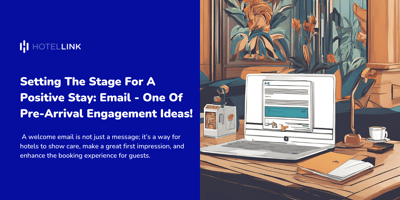As technology continues to evolve, the adoption of digital solutions in the hotel business has...
Top 5 Hotel Decor Styles That Impress Global Travelers
Today’s global travelers have evolved: beyond amenities, they seek unique experiences and memorable emotions - starting from the moment they step into a hotel. Hotel decor is no longer just about aesthetics, but a crucial branding tool that leaves a lasting impression and boosts guest satisfaction. So, which decor styles can truly captivate international guests? Join Hotel Link as we explore the top 5 decor trends and how to successfully bring them into your property.
Why Should Hotels Invest in Decor?
In an ever‑competitive tourism landscape and shifting traveler preferences, investing in interior design is more than decorative - it’s a strategic business move. According to Booking.com (2024), 85% of travelers consider interior design a key factor in choosing accommodation and are willing to pay more for visually striking experiences.*
Today, hotel rooms are no longer just places to sleep - they’re social media-worthy stages for check-ins and viral videos. In this “Instagram-worthy travel” era, a well-designed space with distinct features can:
-
Enhance brand visibility through organic guest-shared photos
-
Elevate emotional and aesthetic appeal, boosting willingness to pay
-
Create a “wow” factor that leaves a lasting impression
-
Increase repeat stays and attract new, especially international, guests seeking novelty
Decorating your property is not just beautificationit’s a core strategy to strengthen brand identity, boost revenue, and stand out in the global market.
*Source: “Hottest Hues and Styling Cues – Booking.com Reveals The Top Trends for Summer Holiday Homes”
Which Decor Styles Captivate Global Travelers?
1. Scandinavian – Elegant Simplicity

Key Features:
-
Neutral palette: white, cream, light gray, beige
-
Natural materials: light wood, linen, wool
-
Clean lines, optimized space
-
Maximum use of natural light
Why It Works:
Scandinavian style is beloved in upscale boutique hotels and homestays across Europe, the U.S., and refined travel markets. Its minimalist yet warm aesthetic evokes a homey “feel at home” sensation, resonating deeply with international guests. It aligns well with the trending “slow living” lifestyle.
Tips to Implement:
-
Maximize daylight
-
Use light wood furniture, neutral-toned linen sofas
-
Decorate with black & white art and small greenery
-
Add large mirrors for spaciousness
-
Layered lighting for ambiance
Ideal For: Boutique hotels, upscale homestays, serviced apartments
Example: SP34 Hotel in Copenhagen - a cozy, elegant showcase of Scandinavian design.
2. Tropical Modern – Vibrant & Refreshing

Key Features:
-
Bright hues: green, sandy yellow, turquoise
-
Local materials: bamboo, rattan, pottery
-
Open design blending indoor/outdoor
-
Natural lighting and airflow
Why It’s Impactful:
For travelers from temperate or urban climates, a tropical escape is irresistible. This style marries personality with ultimate relaxation, perfect for beachside hotels, villas, and resorts in Bali, Phuket, Phu Quoc. It suits the growing eco-conscious travel trend, emphasizing nature and local culture.
Tips to Implement:
-
Choose rattan, bamboo, reclaimed wood furniture
-
Use linen curtains and ceiling fans
-
Include large indoor plants (e.g., monstera, ferns)
-
Create outdoor relaxation corners with rattan furniture
-
Introduce water elements (mini fountain or pool)
Ideal For: Beach resorts, tropical villas, eco-resorts
Example: The Slate Resort (Phuket) - a fusion of tropical aesthetics and contemporary art, rooted in local identity.
3. Japandi – Japanese-Nordic Fusion
Key Features:
-
Minimal but warm, serene
-
Materials: oak wood, handcrafted ceramics, linen
-
Earthy tones: wood brown, charcoal black, muted green-gray
-
Open spaces with minimal furnishings
Why It Resonates:
Japandi combines Japanese Wabi-Sabi philosophy with Scandinavian practicality. A perfect retreat for guests seeking balance and tranquility, especially those from crowded cities needing mental detox. It appeals strongly to Millennials and Gen Z who value mindful living.
Tips to Implement:
-
Choose natural, authentic materials
-
Use soft, warm lighting
-
Minimize clutter; focus on functionality
-
Design a meditation nook with cushions
-
Use bamboo screens for subtle room divisions
Ideal For: Boutique hotels, meditation retreats, retreat villas
Example: K5 Hotel (Tokyo) — a harmonious blend of Japanese flair and Nordic calm.
4. Industrial Chic – Modern & Edgy

Key Features:
-
Exposed brick, pipes, polished concrete
-
Metal, vintage wood, leather furnishings
-
Retro or Edison-style lighting
-
Raw finishes, cement or brick walls
Why Guests Love It:
Industrial-chic injects personality, modernity, and cool urban edge. Attracts young, creative travelers - digital nomads, freelancers - seeking unique and inspiring stays. Perfect for workation trends post-pandemic.
Tips to Implement:
-
Keep brick or cement walls exposed
-
Blend vintage furniture with modern tech (smart TV, power outlets)
-
Add neon signs or urban-themed posters
-
Create work nooks with wooden desks and metal chairs
-
Use industrial-style shelves for decoration
Ideal For: Upscale hostels, city hotels, coworking co-living spaces
Example: The Hoxton Hotel (London) - known for its industrial-style design and urban art vibe.
5. Local Heritage Fusion – Cultural & Contemporary
Key Features:
-
Handcrafted textiles: pottery, silk, woven bamboo, carved wood
-
Ethnic colors: earthy red, turmeric yellow, indigo
-
Traditional patterns blended with modern furniture
-
Folk art meets contemporary comfort
Why It Stands Out:
International travelers crave experiences that immerse them in local culture. Heritage fusion tells a story through design, offering a deeper cultural connection. Perfect for destinations seeking authentic storytelling through space.
Tips to Implement:
-
Use local fabrics for cushions and wall hangings
-
Feature native crafts: bamboo hats, fans, pottery
-
Keep it balancedb - avoid visual overload
-
Combine with contemporary art for harmony
-
Integrate traditional colors subtly
Ideal For: Luxury resorts, heritage villas, cultural hotels
Example: Azerai La Residence (Hue, Vietnam) - French colonial architecture meets modern Asian decor.
Bonus Trend: Biophilic Design
This design fosters connection with nature:
-
Living green walls
-
Abundant natural light
-
Gentle ambient sounds (water, birds)
-
Organic materials: stone, untreated wood, bamboo
Why It Matters:
Biophilic design aligns with the growing demand for wellbeing tourism. A tranquil, nature-infused environment supports guests’ physical and mental health.
Read more: What Makes Wellness Tourism Appealing?
The Role of Technology in Modern Decor
Enhancing guest experience through smart room features:
-
Smart room controls: lighting, temperature, and curtains via app
-
Mirror TVs: space-saving hidden screens
-
Wireless charging surfaces
-
Voice control for devices
Sustainability tech:
-
Smart LED lighting with adjustable colors
-
Motion sensors for automatic lighting
-
Touchless water fixtures and smart toilets
How to Apply These Styles Effectively
-
Analyze Your Guests
-
Where are they from? Age/income? Travel purpose?
-
Average stay duration?
-
-
Study Location & Environment
-
Consider climate, local culture, surroundings
-
Learn from competitors
-
-
Phases
-
Phase 1: Lobby/common areas
-
Phase 2: Sample rooms
-
Phase 3: All rooms and amenities
-
-
Measure Success
-
OTA review scores
-
Number of shared guest photos
-
Repeat guest rate
-
RevPAR before vs. after renovation
-
Common Decor Mistakes
-
Designing for personal taste instead of target guests
-
Overlooking practicality and maintenance
-
Neglecting lighting - transformational for atmospheres
-
Lacking cohesion across areas - avoid inconsistent themes
Conclusion: Stand Out Through Space
Global travelers today have higher expectations than ever. They seek feelings, ambiance, and the story behind every stay. Investing in appropriate decor not only helps your hotel stand out but also creates memorable experiences – something any marketing campaign would struggle to replace.
In an age where everything can be "Googled," emotional experiences become the most crucial differentiator. A thoughtfully designed space doesn't just satisfy guests; it transforms them into natural "brand ambassadors," spreading a positive image of your hotel. Remember, investing in space design isn't an expense; it's a long-term investment for your business's sustainable growth.
Additionally, to fully capitalize on your design's value, your hotel also needs an efficient operational and distribution system to bring that wonderful space closer to potential guests.
Hotel Link offers a comprehensive suite of management solutions, from Booking Engine, integrated Websites, and Channel Manager to the Hotel Link Pay payment solution. These tools help you synchronize your brand image, enhance the booking experience, and optimize business performance. Contact Hotel Link today for advice on operational technology – creating a consistent, distinctive, and effective experience for global travelers.



